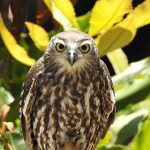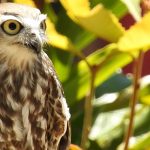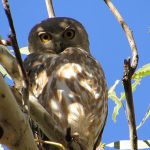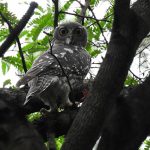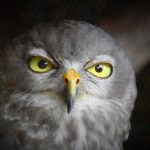BARKING OWL
Australia’s Nocturnal Storyteller
Imagine stepping into the stillness of the Australian night. The moon casts gentle silver light through the Eucalypt branches. Suddenly, across the landscape, a sound rings out—uncannily similar to a dog’s bark. This is not the call of a four-legged friend, but the voice of one of Australia’s most intriguing birds: the Barking Owl.
Physical Description
The Barking Owl is a medium-sized owl, immediately recognisable by:
- Large, bright yellow eyes that gleam even in the faintest light;
- Brown, dappled plumage adorned with whitish spots and streaks, helping it blend with the bark and foliage;
- Rounded wings and tail, perfect for agile, silent flight;
- Distinctive facial discs, which channel sound to their keen ears.
They stand roughly 35–45 centimetres tall—about the length of a school ruler—and possess a wingspan that can stretch to nearly one metre.
Habitat and Range
Barking Owls favour a variety of wooded habitats, including:
- Eucalypt forests
- Woodland fringes
- Riverine environments
Their range extends along the eastern and northern edges of Australia, from southern Queensland, through New South Wales and Victoria, and into parts of Western Australia and the Northern Territory.
The Unique Call
The Barking Owl receives its name from its unmistakable call.
- Primary call: A double ‘wook-wook’ or ‘woof-woof’, remarkably similar to a small dog barking.
- Other vocalisations: Includes shrill screams, which have famously been described as ‘blood-curdling’. These frightening cries are sometimes called the ‘screaming woman call’.
At night, their chorus echoes across woodlands, often startling those unfamiliar with this nocturnal musician.
Diet and Hunting Behaviour
These owls are adaptable and opportunistic hunters. Their diet often includes:
- Small mammals, such as possums and bats
- Birds, reptiles, frogs, and large insects
They hunt mainly from perches, launching swiftly and silently onto prey. Their sharp talons and powerful beak finish the hunt quickly.
Life Cycle and Social Structure
Barking Owls typically form monogamous pairs, and breeding usually takes place from August to October. They nest in large hollows of old eucalyptus trees, lining their nest with leaves and old wood chips.
Eggs and Young:
- Usually 2–3 eggs are laid per clutch.
- Both parents share the task of caring for the chicks.
- Young owls fledge after about 40 days, venturing into the world under the watchful eyes of their parents.
Conservation Status
Although once widespread, Barking Owl populations are now in decline in some regions, especially in southern Australia. Their main threats include:
- Loss of old-growth trees with suitable nesting hollows
- Habitat fragmentation
- Decline of prey due to land clearing and altered fire regimes
Currently, the species is:
| Region | Conservation Status |
|---|---|
| National | Least Concern (IUCN) |
| Victoria | Threatened |
| NSW | Vulnerable |
Protecting Barking Owls means safeguarding whole ecosystems. When forests and riverbanks are healthy and old-growth trees are allowed to stand, these remarkable birds can continue their nightly song. Every choice to preserve such habitats benefits not only Barking Owls, but a tapestry of wildlife woven through Australia’s wild places.
In the hush of night, the Barking Owl’s voice reminds us that the land is alive, full of stories yet to be discovered.


